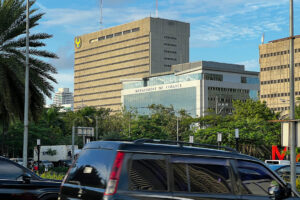




Policy Rate Updates: Double cut finale
 DOWNLOAD
DOWNLOAD

Monthly Economic Update: One for the road
 DOWNLOAD
DOWNLOAD

Inflation Update: Still low, still slow
 DOWNLOAD
DOWNLOAD


Bangko Sentral likely to cut benchmark rates by Q2

The Bangko Sentral ng Pilipinas (BSP) may start cutting interest rates as early as the second quarter of next year amid easing inflation, according to an economist.
“There’s some chance that the BSP might start cutting rates by the second quarter,” University of Asia and the Pacific (UA&P) economist Victor A. Abola told an online forum hosted by UA&P and the Business Economics Club on Wednesday.
Inflation might continue to go down within the 2-4% target of the Philippine central bank in the first quarter, he added.
The BSP kept borrowing costs steady on Nov. 16 amid easing inflationary pressures. This was after the Monetary Board hiked the key rate by 25 basis points (bps) in an off-cycle move three weeks earlier, bringing it to a 16-year high of 6.5%.
The central bank on Nov. 16 said policy settings must be kept sufficiently tight until a sustained downtrend in inflation becomes more evident and inflation expectations are anchored.
“The BSP made a mistake in raising it in the first place because that was before the (October) inflation data were released, where we saw a big downward shift in inflation,” Mr. Abola said.
Headline inflation fell to 4.9% in October from 6.1% in September. It marked the 19th straight month that inflation breached the BSP’s 2-4% target. For the 10-month period, inflation averaged 6.4%.
BSP Governor Eli M. Remolona, Jr. earlier said the Philippines is not “out of the woods” yet despite the slowdown in October inflation.
He said inflation might only return to 2-4% briefly in the first quarter before picking up to above target again in April to July.
Mr. Abola said inflation might average 6.2% this year before easing to 4.2% in 2024. Both projections are still above the 2-4% target and higher than the BSP’s inflation forecast of 6% in 2023 and 3.7% in 2024.
The policy outlook would largely depend on inflation numbers next year, Michael L. Ricafort, chief economist at Rizal Commercial Banking Corp. said in a Viber message.
“If oil prices continue the declining trend especially if the Israel-Hamas war does not spread in the Middle East, and if local weather conditions are relatively better with no major storms and damage from El Niño, the BSP could start cutting policy rates in 2024,” he said.
But worsening war in the Middle East could result in higher oil prices, while damage from typhoons and the El Niño phenomenon could lead to higher food prices.
If inflation worsened next year, a “more hawkish/restrictive monetary policy could be needed to better anchor inflation and inflation expectations toward the BSP’s target of 2-4%,” Mr. Ricafort said.
The central bank’s policy decisions next year would also depend on the exchange rate and future moves of the US Federal Reserve, Luis A. Limlingan, head of research at Regina Capital Development Corp., said in a Viber message.
“We think that the BSP would possibly start cutting rates in 2024 so long as inflation falls within the acceptable range of 2-4% preferably, closer to 2%,” he added.
Mr. Remolona earlier said the Monetary Board was not considering any rate cuts this year and policy decisions would remain data-dependent.
The Monetary Board is set to hold its last rate-setting meeting of the year on Dec. 14. — Keisha B. Ta-asan
This article originally appeared on bworldonline.com





 By BusinessWorld
By BusinessWorld